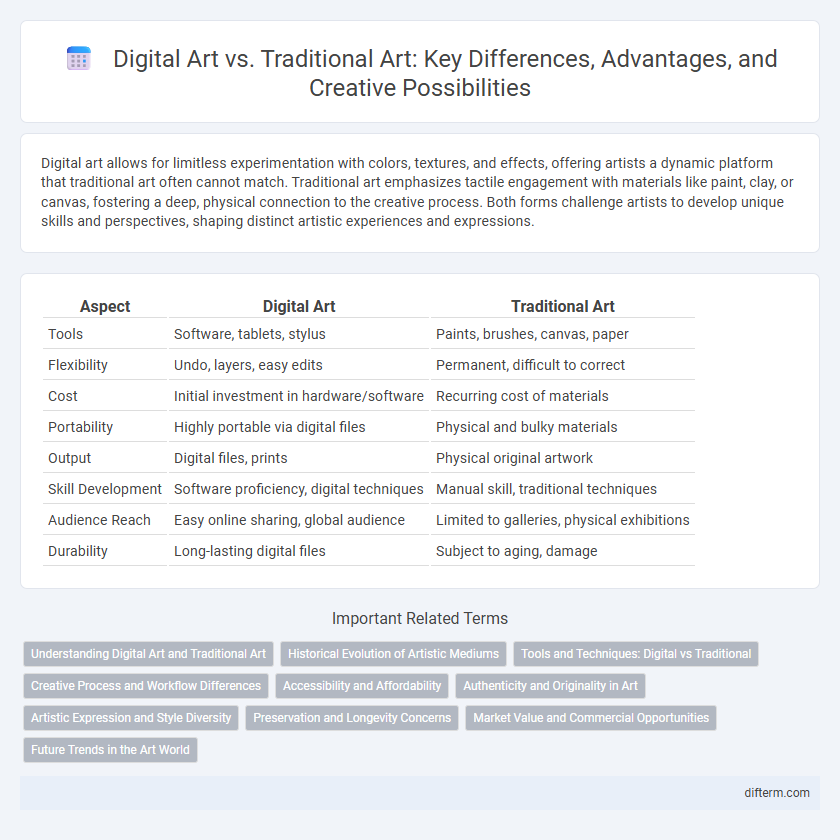Digital art allows for limitless experimentation with colors, textures, and effects, offering artists a dynamic platform that traditional art often cannot match. Traditional art emphasizes tactile engagement with materials like paint, clay, or canvas, fostering a deep, physical connection to the creative process. Both forms challenge artists to develop unique skills and perspectives, shaping distinct artistic experiences and expressions.
Table of Comparison
| Aspect | Digital Art | Traditional Art |
|---|---|---|
| Tools | Software, tablets, stylus | Paints, brushes, canvas, paper |
| Flexibility | Undo, layers, easy edits | Permanent, difficult to correct |
| Cost | Initial investment in hardware/software | Recurring cost of materials |
| Portability | Highly portable via digital files | Physical and bulky materials |
| Output | Digital files, prints | Physical original artwork |
| Skill Development | Software proficiency, digital techniques | Manual skill, traditional techniques |
| Audience Reach | Easy online sharing, global audience | Limited to galleries, physical exhibitions |
| Durability | Long-lasting digital files | Subject to aging, damage |
Understanding Digital Art and Traditional Art
Digital art harnesses modern technology such as graphic tablets, software like Adobe Photoshop, and digital canvases to create versatile and easily modifiable artworks. Traditional art relies on physical materials and techniques including oil paints, charcoal, and canvas, emphasizing tactile skill and texture. Both forms offer unique expressive possibilities, with digital art facilitating rapid experimentation and traditional art providing rich sensory experiences.
Historical Evolution of Artistic Mediums
The historical evolution of artistic mediums highlights a significant shift from traditional art forms such as painting, sculpture, and drawing to digital art created with software and digital tools. Traditional techniques based on physical materials like canvas, clay, and pigment have been augmented by digital technologies enabling new possibilities in image manipulation, animation, and interactive experiences. This transformation reflects broader technological advancements and changing artistic expressions, influencing how art is produced, shared, and perceived globally.
Tools and Techniques: Digital vs Traditional
Digital art utilizes software programs like Adobe Photoshop, Procreate, and Corel Painter, offering versatile brushes, layers, and undo options that enable precise modifications and experimentation. Traditional art relies on physical tools such as oil paints, charcoal, canvas, and brushes, which provide tactile texture and organic variations unique to manual techniques. The choice between digital and traditional tools significantly influences artistic workflow, style, and the final aesthetic quality of the artwork.
Creative Process and Workflow Differences
Digital art utilizes software tools and layers, allowing artists to experiment with undo, filters, and instant color adjustments, which streamlines revisions and accelerates workflow. Traditional art relies on physical materials like canvas and paint, requiring careful planning and drying times, making the creative process more tactile and deliberate. The digital workflow supports rapid iteration and easy modification, while traditional methods emphasize texture and physical presence, impacting the artist's interaction with their medium.
Accessibility and Affordability
Digital art offers unparalleled accessibility, enabling artists worldwide to create and share work instantly using affordable software and devices. Traditional art often requires costly materials and dedicated studio space, limiting participation based on economic factors. The lower entry barrier for digital art democratizes creativity, expanding opportunities for diverse artistic expression.
Authenticity and Originality in Art
Digital art challenges traditional notions of authenticity by allowing easy replication and modification, yet it fosters originality through innovative tools and techniques unavailable in traditional media. Traditional art holds intrinsic value tied to the physical presence of the artwork, with unique textures and materials that authenticate its originality. Both forms redefine authenticity and originality, with digital art emphasizing conceptual innovation and traditional art emphasizing tangible uniqueness.
Artistic Expression and Style Diversity
Digital art offers unmatched flexibility in artistic expression, allowing creators to experiment with vibrant colors, intricate textures, and dynamic effects that traditional mediums may struggle to achieve. Traditional art, rooted in centuries of techniques, provides unique tactile experiences and authentic stylistic nuances that convey emotional depth through physical brushstrokes and material textures. The diversity in style between digital and traditional art expands the creative landscape, fostering innovation while honoring time-tested artistic traditions.
Preservation and Longevity Concerns
Traditional art often benefits from proven preservation methods such as controlled environments and physical restoration, ensuring longevity over centuries. Digital art relies heavily on evolving technology, file formats, and storage media, making it susceptible to data corruption and obsolescence. Preservation of digital art requires continuous migration to current platforms and formats to maintain accessibility and integrity.
Market Value and Commercial Opportunities
Digital art increasingly commands higher market value due to its scalability and appeal to tech-savvy collectors, with platforms like NFTs expanding commercial opportunities. Traditional art retains strong market presence driven by historical significance, rarity, and physical provenance, attracting established collectors and galleries. Commercially, digital art leverages global online marketplaces, while traditional art benefits from prestigious auction houses and physical exhibitions.
Future Trends in the Art World
Digital art is rapidly evolving with advancements in AI-generated imagery, augmented reality, and blockchain technology, offering new ways for artists to create, distribute, and monetize their work. Traditional art continues to hold cultural and tactile value but increasingly integrates digital techniques to enhance creativity and reach global audiences. Future trends indicate a hybrid approach where digital innovation complements classical methods, transforming the art world's dynamics and expanding the definition of artistic expression.
digital art vs traditional art Infographic

 difterm.com
difterm.com